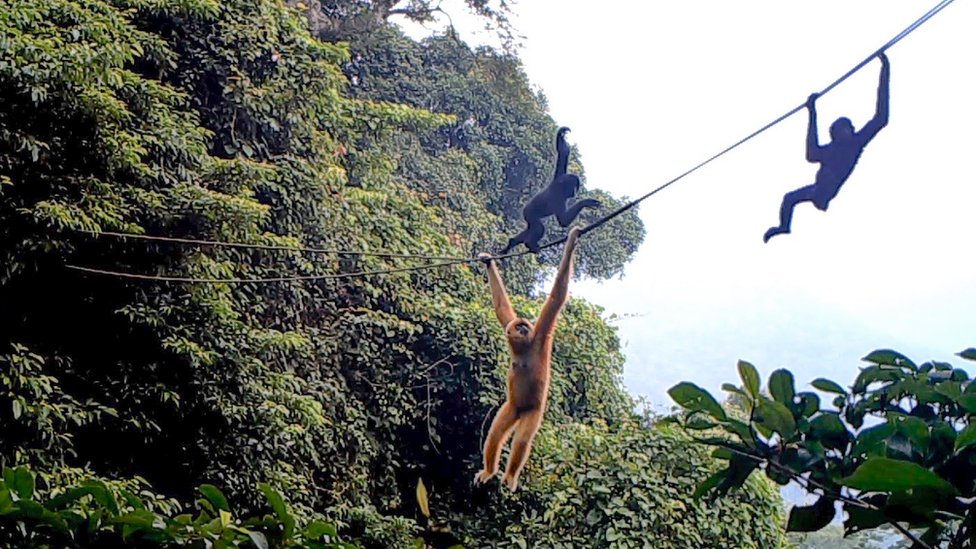

image copyrightKadoorie Farm and Botanic Garden
Swinging through the treetops comes naturally for gibbons.
But that’s tricky if a landslide has torn a huge gap in the forest, making it difficult to roam far and wide, to find food or meet a date.
For the rarest primate in the world, there’s now a temporary solution: a rope bridge reconnecting the trees.
And scientists have filmed the ape, a type of gibbon, climbing or swinging across in seconds.
Some used the ropes as a handrail, others swung by their arms and the most daring walked the tightrope.
All nine in the group mastered the rope bridge, save one adult male, which made a mighty jump from one tree to another, sometimes accompanied by athletic teenage companions.
Conservation scientists say the 18-metre-long structure could be an essential lifeline for the endangered species, while the forests are restored to their former glory.
A small number of primates, including the orangutan, have been seen to use artificial rope bridges. But this is the first time the Hainan Gibbon, which lives only in the forests of China’s Hainan island, has learnt the ropes.
image copyrightKadoorie Farm and Botanic Garden
A conservation programme run by the Kadoorie Farm and Botanic Garden in Hong Kong is trying to rescue the species from extinction.
Dr Bosco Chan says the rope bridge should help boost numbers as part of various conservation efforts.
“When we started work at the reserve, in 2003, we could only find two groups with a total of 13 individuals were left in the entire world,” he told BBC News.
“The gibbon population has gradually recovered, with a third and fourth family group formed in 2011 and 2015, respectively.
“At the beginning of 2020, we confirmed the formation of the fifth group, and the world population has bounced back to over 30 individuals. It shows the species is slowly recovering, and we should have hope.”
Reforestation should be the priority in preventing extinction of the species, he added.
“We need to make sure we control poaching effectively, expand lowland forest which is the optimal habitat for gibbons, and keep monitoring the gibbon groups to predict and prevent any threats. “
image copyrightKadoorie Farm and Botanic Garden
Once common across China, the apes are now confined to a patch of forest on the island in the South China Sea.
Within their habitat, they travel above ground from tree to tree. Gaps in the canopy, both natural and man-made, can tie them to a specific area, interfering with foraging and breeding, and increasing the risk of predation.
Nearly 20 gibbon species exist throughout the world, from northeastern India to Borneo. Most are under threat from the destruction of forests, hunting and illegal trade.
Two species of gibbon have recently disappeared in China and all surviving Chinese species, including the Hainan Gibbon (Nomascus hainanus), are classified as Critically Endangered by the International Union for the Conservation of Nature.
The study is published in the journal, Scientific Reports.
Follow Helen on Twitter.
Read MoreFeedzy
A business can develop in many ways. One of the best ways to grow your…
American families are once again juggling the seasonal custom—and financial burden—of back-to-school shopping as the…
Want to bond over unexpected activities? Look at these unconventional ways to connect with your…
Burnout isn’t just something that happens to CEOs. For moms homeschooling littles, it’s a very…
When it comes to long-distance motorcycling, comfort, reliability, and smart engineering can make or break…
Flowers have seen significant transformation over time; online flower shopping is increasingly common now for…